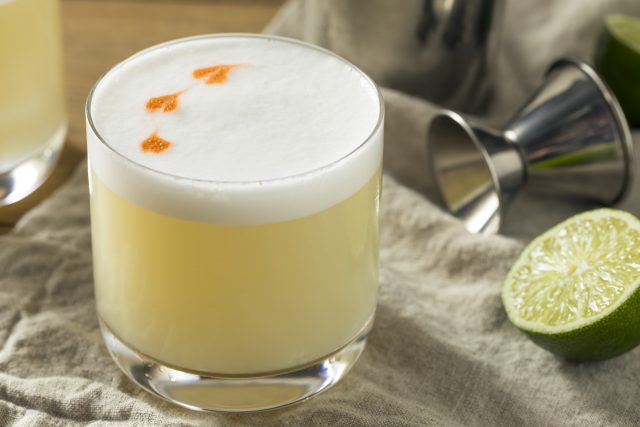Where does Pisco come from?
By Louis ThomasAhead of World Pisco Sour Day tomorrow, db considers the contentious issue of whether Peru’s national spirit is actually Chilean.

The history of Pisco (pronounced ‘Peace-co’) begins with the Spanish conquistadores, as Pan-American beverage consultant and Peruvian Pisco champion Kammi Kenna explained to db: “Grapes were imported to the Americas, like wheat, and like sugarcane, by the Iberians starting in the 16th century. Remember, that a powerful tool in their campaign for control over the people in all of the American territories was religion, and grapes for the sacramental wine played a large role in that. Grapes were first planted in Lima, Peru as early as 1539 and wines were made from them as early as 1551. The first Piscos (aguardiente de uva) were made when King Phillip IV prohibited Peruvian wine in Spain from competing with Spain’s wine industry, wine makers turned to distilling the wines that they no longer had a market for. However, it is important to note that the production of spirits from grapes was an existing practice on a small scale, used to fortify the wines in some cases.”
The general consensus is that Pisco is so-named because in the centuries following the arrival of the conquistadores, the port of the city of Pisco (in what is now southwestern Peru) became known for exporting the spirit. The word ‘Pisco’ actually originates from the indigenous Quechuan word for ‘bird’ (though there is debate that maybe it means a pot of some description), likely a reference to the area’s wildlife. Indeed, the earliest reference to a spirit called ‘Pisco’ dates from 1764 in a customs record from Spain, showing a high volume of exports of an aguardiente from the Port of Pisco.
But what makes the conditions of Southern Peru suited for Pisco production? Kenna explained: “The southern coast of Peru is arid and desertic. In fact, the primary grape used in the production of pisco garners its name from this fact; Quebranta. Quebranta comes from the Spanish verb ‘quebrar’, which means to break – as in to break through the arid soils. The thing that is most intriguing to me is the fact that the Denomination of Origin for Pisco from Peru is the verticality of it, the DO states that Pisco can be made in grape-producing valleys in 5 states (Lima, Ica, Arequipa, Moquegua, and Tacna) from 0 to 2,000 metres above sea level.”
“The Andes mountains descend into South America’s Westernmost coastline, the coastline of Southern Peru. The dramatic topography creates a multitude of microclimates between the foot of the gigantic range and the Pacific Ocean that give way to verdant valleys, rich for agriculture. The Andes provide a rich supply of water from snow melt and rainwater making its way to the sea, which is important given that it does not rain on the coast – ever.” The Humboldt Current also plays a role, bringing cooling air to moderate the climate.
National rivalry
But Pisco is a drink with an identity crisis. While in Europe and the US it is largely associated with Peruvian bars and restaurants, Chile also produces Pisco, and Chileans would argue that their country has a valid claim to be its homeland. In 1931, a Designation of Origin (DO) was issued for Chilean Pisco. That year, President Carlos Ibáñez del Campo’s Decree N°181 ruled that the term ‘Pisco’ was exclusively reserved for grape brandies made in the departments of Copiapó, Huasco, La Serena, Elqui and Ovalle. Peruvian Pisco, by contrast, was granted a DO in 1991, meaning that there is now a legal stalemate for claim of ownership.
It’s an issue which has caused much sabre rattling over the years. In 1936, the village of La Unión, north of Santiago, was renamed as Pisco Elqui in a gesture to strengthen Chile’s claim to Pisco, much to the chagrin of the Peruvians.
But, amid the squabbling, it is easy to forget that Chilean and Peruvian Pisco are actually quite different products, with quite different productions, as Cortés explained: “In Chile, we only use Muscat grapes, and even those called ‘creoles’ grapes are a mix of Muscats, so in Chile, we say that we work 100% with aromatic grapes. These are all muscats such as Alexandria, Pink and Austrian. Creole grapes are Pedro Jimenez (with the ‘J’ to differentiate from Pedro Ximenez in Spain), and Torontel is used too for increasing the yields due to some difficulty setting the fruits during flowering. Chilean Pisco grapes were installed during the colony through importation from Argentina. After obtaining independence from Spain, Chileans put all the Spanish vines away, trying to erase any sign of Spain in the countryside.”
“In this context,” he added, “I can say that Peru works only 20% of its production with aromatic grapes. They use other breeds that the Spaniards imported during the colony, such as Mollar , Quebranta etc. These vines are not perfumed, and they can be obtained twice a year due to the climatic conditions of tropical viticulture. In Chile, we produce once a year, and our climate is Mediterranean. This helps a lot to develop aromas and quality sugars.”
Partner Content
There is also a difference in distillation, as Cortés elaborated: “In Peru, they use semi-discontinuous distillation, which means they use the ending part to finish the production, this part also called “queue”, hasn’t a relevant alcohol content, so it helps to reduce the strength of the heart obtained in precedent steps of distillation…Chile uses a technique that’s more similar to Cognac, and we go on discontinuous distillation, which means we separate the distillation into head, heart and queue.”
Likewise, while Peruvian Pisco is not classified at all by its ABV, Chilean Pisco is segmented by ABV, going from Corriente/Tradicional at 30-34.9% all the way up to Gran (which is barrel-aged for over a year) which is 43-50%. Peruvian Pisco cannot be aged in wood and is not diluted after distillation. Though there is a great deal of variation possible within both country’s DO requirements, as a rule of thumb, Chilean Pisco will typically have more floral character due to the varieties used.
For Kenna, the deviation of how Chilean Pisco is produced is enough for her to not call it ‘Pisco’ at all, instead referring to it as “Chilean brandy”. Explaining why the term ‘Pisco’ is used in Chile, Rodrigo Flores Cortés, from the Pisco Chile association, said: “The Quechua language was spoken by the Inca Empire, and its extension was from current Ecuador to Southern Chile, finding its limit at the edge of the river Bio-Bio, which was a natural border established between Mapuche people and the Incas to avoid confrontations in the territory. However, Quechua was spoken as lingua franca in Chile, coexisting with other local languages, such as Kakan, Mapudungun, Aymara or Kunza, belonging to natives living in the southern central and northern Chile.”
“Before the arrival of Spaniards in our territory, Chile and Peru belonged to the same country, ruled by the Inca Empire, but even when it was colonised, the exact structure of the ‘country’ was used by the Spanish crown to manage the population and their assets…it was at the end of the colonial period when the King of Spain decided to separate the territory and the people in a very arbitrary way, sweeping away any trace of shared identity of both countries,” Cortés added. Indeed, though Pisco was likely first produced in what is now Peru, the country itself was only founded in 1821 (three years after Chile).
The reason why Peruvian Pisco is more well-known internationally is largely due to exports. Domestic consumption of the spirit is relatively low in Peru, but exports are high, with the US being the biggest market. The inverse is true of Chile, where, according to Flores, approximately 97% of the 35,000,000 litres of Pisco produced each year is consumed within the country.
Peace-co at last?
Neither Peru nor Chile is likely to concede the right to call their spirits ‘Pisco’, for the sake of national pride, tradition and, of course, marketing. The odds are, if you are having Pisco outside of Chile, it is probably Peruvian.
An appropriate parallel to draw might be with Scotch whisky versus Irish whiskey. Though they share a common ancestor, they have diverged into separate drinks, and neither is ‘truer’ or more ‘authentic’ than the other. Crucially, both are acceptable in a Pisco Sour, which, though probably invented by American bartender Victor Morris in a Lima bar in the early 20th century, is the national drink of both Peru and Chile (though in the latter, lemon juice is typically used instead of lime).
Considering its somewhat confused heritage, and the range of terroirs, grape varieties and distillation methods it is possible to use in its production, perhaps Pisco should in fact be considered as a broader drinks category, rather than a specific drink, though it seems unlikely that either side would take kindly to such a compromise.
The conquistadores also introduced brandy making to Bolivia. db recently spoke with Hollywood director Steven Soderbergh about his passion for the country’s national drink, Singani.
Related news
Is Japanese whisky losing its auction lustre?
Calls mount to regulate 'sham scammer' whisky cask investment industry




